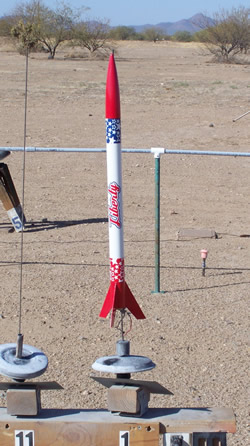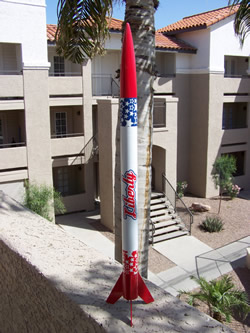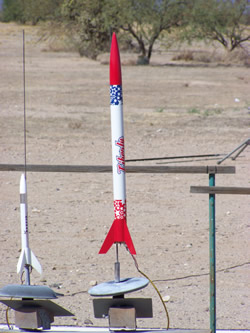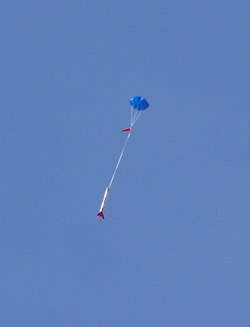| Construction Rating: | starstarstarstarstar_border |
| Flight Rating: | starstarstarstarstar |
| Overall Rating: | starstarstarstarstar_border |
| Published: | 2010-03-23 |
| Diameter: | 1.63 inches |
| Length: | 29.63 inches |
| Manufacturer: | Custom Rockets  |
| Skill Level: | 2 |
| Style: | Sport |

Brief:
This is a single stage, plastic nose cone, three fin rocket and it utilizes an eighteen inch
parachute for recovery. The fins are balsa and there are two recommended motors, the D12-3 and the D12-5 which are
secured by a metal motor retaining clip.
Construction:
The body tube of the rocket is in two pieces, with the lower tube only three inches long
which houses the motor mount. The tubes are the standard cardboard material used in most low powered rockets. The
nosecone is plastic and is approximately eight inches long, including the section inside the body tube. It has three
fins made of balsa and a 3/16 inch launch lug. The shock cord is 1/4 inch elastic which is attached to the body tube
with the Estes tri fold method. The instructions says it needs twelve to fifteen sheets of wadding for flight. It has a
standard design motor mount similar to the Estes type, with cardboard centering rings. The motor mount is placed in the
three inch lower body tube which is later attached to the longer upper body tube.
The instructions were easy for me to follow. It is a straight forward model to build. You'll need basic building
skills and use white or carpenter glue for fillets for the balsa fins. The three inch body tube is painted red (with
fins), the nosecone red and the main body tube white. You can paint all these segments before connecting them all
together which means there is no masking before painting. The decals were of the pressure sensitive type and went on
easily. After assembling the body tubes, nosecone and applying the decals the rocket may be given a coat of gloss clear
paint to finish things off and give the rocket a uniform shine over it's total length. Make sure you give the paint
enough time to dry before applying the gloss finish. This time could be a few days long
 depending on
the paint used. I found it an easy rocket to build. The only thing I can think of that is a problem is that the inside
edge of the fins can get slightly damaged by the motor exhaust heat and may need to be touched up a few times with
paint. I've had to touch mine up with red paint two times already. This can be minimized by using a clothes pin on the
launch rod to give the rocket a little more room between the blast deflection plate and the bottom of the rocket.
depending on
the paint used. I found it an easy rocket to build. The only thing I can think of that is a problem is that the inside
edge of the fins can get slightly damaged by the motor exhaust heat and may need to be touched up a few times with
paint. I've had to touch mine up with red paint two times already. This can be minimized by using a clothes pin on the
launch rod to give the rocket a little more room between the blast deflection plate and the bottom of the rocket.
Finishing:
Because the sections of the rocket are finished separately, and then assembled, the painting
of this rocket is simple with no masking needed, except for masking off the shoulder of the nose cone so it will fit
inside the body tube. Be careful when taking the tape off the nosecone after painting it since it may have a tendency
to flake off on the section you want to keep red. Taking the masking tape off the nosecone before the paint is fully
hard minimizes this I think. The decals are nice and went on easily. The gloss paint finish will help keep them from
peeling. I feel the rocket looks pretty nice when finished. I modified my rocket by using a blue nylon parachute
instead of the plastic one provided. I wanted to treat this one a little special since it is one of the larger rockets
in my fleet. With the large body tube it will fit a nylon parachute easily.
Construction Rating: 4 out of 5
Flight:
The recommended motors are the D12-3 and the D12-5. I've only flown it with D12-5's so far. For me,
it gets decently high on the D12-5. It's hard for me to tell where the ejection is at the apogee since it is so high.
For all my flights, it has flown well and had soft landings. I use both Estes and Quest wadding, using two sheets of
Quest wadding first, then about ten sheets of Estes wadding. The Quest wadding is a little bigger and somewhat tougher
than the Estes.
Recovery:
I used 1/4 inch elastic for the shock cord. For my rocket I used a longer length, I think
about six foot long, to avoid any problems with the nosecone bouncing back and hitting the rocket body during ejection.
So far I have had no problems with the nosecone hitting the rocket. The fins seem to get slightly damaged on the inside
edge by the motor exhaust heat and may have to be touched up periodically with paint (the paint seems to bubble). After
five flights the finish is starting to show some wear from scratches. The parachute descent may be a bit slow, but is
acceptable for me. I've never timed it, but It flies so high it may need over a minute to
 come back to
the ground. It's just an estimate.
come back to
the ground. It's just an estimate.
Flight Rating: 5 out of 5
Summary:
It's a great rocket. The assembly is easy, painting is simple, and it flies straight and
smooth. It looks really nice once assembled. On the other hand, it only uses D12 motors, the plastic which the nosecone
is made of may cause the paint to flake off if you are not careful, and the paint on the inside edge of the fins may
bubble from the motor exhaust heat. On the whole I really like this rocket and try to fly it as much as possible.
Overall Rating: 4 out of 5
Other:
Simple to build and has a lot to offer for the price.
 |
 |
Flights
Sponsored Ads
 |
 |











